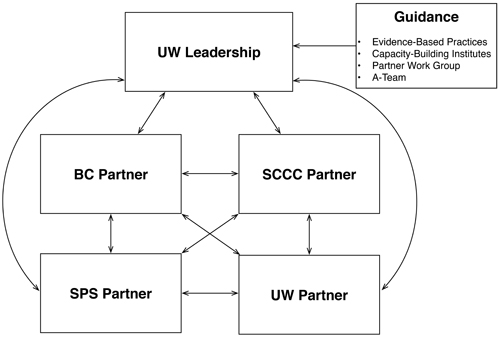Progress of AccessSTEM - Phase II
Progress from 10/1/08 to 4/30/11
The Northwest Alliance for Students with Disabilities in STEM—Phase II (AccessSTEM) is the second of two Alliances funded by the Research in Disabilities Education program of the National Science Foundation and directed by the DO-IT Center at the University of Washington (UW). The first award (#HRD-0227995) was much larger in region (Alaska, Idaho, Oregon, Washington) and funding level. The new Alliance (#HRD-0833504), which continues to be called AccessSTEM, focuses on the local area around the UW.
The following report summarizes project progress half way through the projected five-year current AccessSTEM project. It shares the goal and impact, organizational structure, and progress in reaching the four project objectives.
Goal and Impact
All project activities support the goal of increasing the postsecondary degree attainment of individuals with disabilities in science, technology, engineering, and mathematics (STEM) fields. The ultimate impact is to make STEM opportunities available to more citizens and enhance STEM fields with the talents and perspectives of people with disabilities.
Organizational Structure
The project PI and director is Sheryl Burgstahler. The project manager is Scott Bellman. Project partners are the UW, Seattle Central Community College (SCCC), Bellevue College (BC), and Seattle Public Schools. The AccessSTEM logic model and specific partner logic models provide a summary of project Inputs/Context, Goal/Objectives, Activities, and Results for AccessSTEM.
Evidence-based practices employed in AccessSTEM are determined by results of a literature review, outcomes of prior projects hosted by DO-IT, suggestions from practitioners, and input from students with disabilities. Further refinements come from input from staff (Partner Work Group) and student leaders (ATeam) from partner schools, and results from Capacity Building Institutes. The organizational structure for AccessSTEM is as follows:

Objectives 1 and 2
- Implement changes within partner postsecondary institutions–UW, BC, and SCCC–to make STEM programs more welcoming and accessible to students with disabilities (e.g., more accessible websites and science labs, STEM publications that encourage the participation of students with disabilities).
- Create and expand engagement of stakeholders (STEM educators, disability services, veteran associations, projects that broaden participation in STEM, and industry and career services) to foster STEM education and careers that are welcoming and accessible to people with disabilities. Progress in reaching Objectives 1 and 2.
Objective 3
Implement evidence-based practices (e.g., mentoring, peer support, internships) to increase numbers of individuals with disabilities moving through critical junctures to STEM associate, baccalaureate, and graduate degrees and careers. Progress in reaching Objective 3.
Objective 4
Support and expand an online resource center that shares research and promising practices worldwide. Progress in reaching Objective 4.